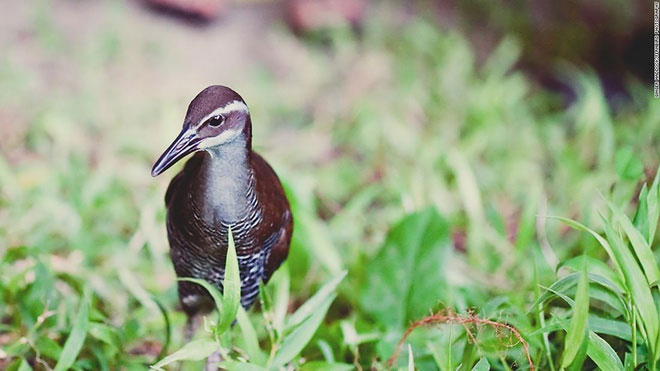Guam island birds back after 40 years of extinction
Guam Island waterfowl - extinct birds in the wild for 40 years - have returned after decades of conservation efforts, originating from the last 21 individuals kept in captivity.
During World War II, the island of Guam was occupied by the Japanese army. Shortly after the island was liberated by the US army in 1944, brown tree snakes appeared. This reptile is thought to have accidentally hitchhiked on cargo trains serving the US military.
For a prey species up to 2.5 meters in length, Guam island becomes their paradise because they do not encounter any enemies here, while the food source is plentiful. The brown tree snake thus grew fast and wiped out 10 of the 12 native bird species on Guam.
Suzanne Media, a wildlife biologist at the Guam Island Ministry of Agriculture, commented that the destruction of birds led to a domino effect . Without birds helping spread seeds, the forests become more sparse. Meanwhile, the spider population previously controlled by birds also skyrocketed.

Guam island chickens have been identified as extinct in the wild over the past 40 years.(Photo: CNN).
The problem does not stop there, the snakes also creep from tree to wire and cause frequent power outages on the island. Solid quantity control schemes are also ineffective. The dead mice, impregnated with acetaminophen, were dropped from an airplane into forests, hoping that snakes would eat them and then die.
Only a small number of Guam Island waterfowl remain and are avoided by snakes. In 1981, conservationists searched the island and found only 21 individuals. They put them in captivity, and Guam island chickens have been identified as extinct in the wild.
Eight years later, conservationists began releasing next-generation birds into their natural habitat, of course not on Guam, where they could be eaten, but on Rota Island in the north, small. more and no brown tree snakes.
Initial re-release efforts have failed, according to Medina. Waterfowl are killed by carts or eaten by feral cats, and they tend to move so wide they can't find each other to breed.
Only in the late 1990s did Medina and her team "discover the secret" to help these birds mate. The trick is to rely on the personality of each bird, build an appropriate "profile" for dating to go well and lead to young birds.
Some males are not interested in mating, even if the female shows clear signs of her being ready, said Laura Duenas, Medina's colleague. While some of the paired up hated each other and attacked the other to death.
In the end, the conservationists' efforts paid off. Many young birds hatch and the species' survival prospects improve. Rota Island is currently home to 200 waterfowl, while 60 to 80 individuals live on the tiny island of Cocos on the southern island of Guam. The number is not large, but Ms. Duenas believes that they will be able to develop sustainably.
- The great tragedy raged and made the island Guam
- Extremely rare set of 12 species of extinct birds
- Birds never ... fly
- Sophisticated, sneaky snake species
- Video: The reason Guam recommends that people not use conditioner when being attacked by nuclear
- American drop bomb mouse
- 'Spring messenger' is in danger of extinction
- Why do birds have no teeth?
- Foreign mice are eating two million young birds on the British island
- Conflict about the origin of birds
- Kill reindeer and mouse to protect birds
- Found fossils of ancient birds after dinosaurs extinction
 'Fine laughs' - Scary and painful torture in ancient times
'Fine laughs' - Scary and painful torture in ancient times The sequence of numbers 142857 of the Egyptian pyramids is known as the strangest number in the world - Why?
The sequence of numbers 142857 of the Egyptian pyramids is known as the strangest number in the world - Why? History of the iron
History of the iron What is alum?
What is alum?